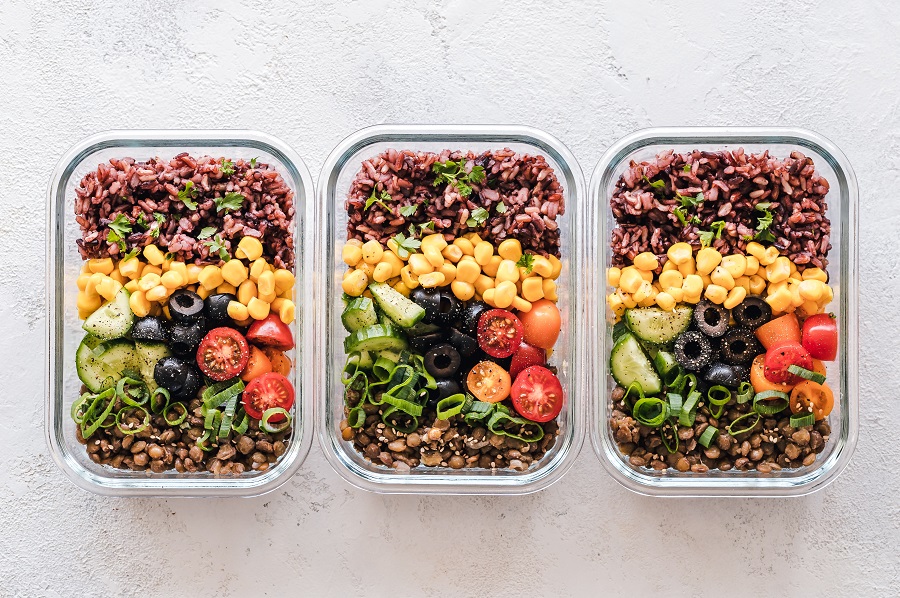To help ease the frenzy of getting to the bus stop, packing backpacks, scheduling after-school activities, and still managing time at home with your family, we’ve compiled some tips and tricks to help make packing your child’s lunch easy and healthy! So where do you start?
Include your kids in the packing process
Having kids involved in preparing their lunches not only increases the likelihood that they’ll enjoy what they’ve packed, but it also builds a foundation for a lifestyle of prioritizing food preparation – making it less likely that they’ll turn to conventional and convenient foods. Turn your kitchen into a “packing station” that’s hands-on and fun!
Make it Nutritious and Delicious
Start with the basic building blocks a complete meal: protein, fat, vegetable, carb. Don’t forget that you can always take your own spin on a variety of recipes to make them your own while still maintaining quality and nutrition. Packaged snacks can contain a host of chemicals in addition to refined ingredients and preservatives that are typically high in sugar, sodium, and saturated fats. By making your own foods, you can ensure that you’re maximizing nutrition and fueling little minds and bodies with all of the right things. As mentioned above, through creating learning opportunities about the nutrition-related benefits of the foods in their lunch, you can even help encourage healthy habits early on.
What to avoid
- Begin the day with balance and set the trend for each meal after. For example, eating fruit alone may lead to an energy crash at midday, in addition to a rumbling tummy. Incorporate healthy fats and some protein for a sustainable start!
- Skip the sugar. In addition to avoiding processed and sugary foods, limiting fruit to a few servings throughout the day can help keep the overall sugar content low and leaves more room for veggies and brain-nourishing fats.
- Say no to sweet treats like candy. Chips, candy bars, suckers, and Smarties often make their way around many classrooms, but teaching your kids that it’s OK to decline and finding a way to compromise may help them be more successful.
- Avoid unnecessary chemicals and additives. High-quality deli meats may be an easy add-in to wraps and gluten-free sandwiches, but you’ll want to ensure they’re nitrate free and sourced from healthy animals – consider purchasing Applegate or Diestel.
Eliminate additional toxin exposure
It’s important to mention that while it’s a priority to find foods that are packed with nutrition and easy to transport, it’s also important that the storage for these foods each day is free of toxins. Even though some plasticware claims to be free of BPA and other chemicals, the alternative ingredients in these products may not be much safer. When looking for storage containers, lunch boxes, and water bottles, look for ones that are BPA-, phthalate- and lead-free. One popular alternative to plastic is stainless steel, especially for kids to bring to school as they’re less fragile than glass in the event they get dropped.
Consider the PlanetBox Eco-friendly stainless steel lunch box. It’s easy for little fingers to open and it has individual sections, so there are fewer containers and lids to lose.
Water Bottles
Two great companies are Lifefactory and Hydro Flask. Lifefactory makes glass water bottles with silicone sleeves. The 9 oz bottles fit well into most lunch boxes, but they also have 12, 16 and 22 oz sizes with straw, sport, and screw on tops. If you can’t take glass to school or you want your beverage to stay insulated (cold or warm), a Hydro Flask may be the way to go. They have a variety of interchangeable lids for different size bottles.
Reusable Sandwich Bags and Clingwrap
Two companies that we like for reusable sandwich bags are LunchSkins and Abbego which has a beeswax coating.
Other Tips & Recipe Ideas
- Prepare ahead with leftovers from dinner the night before. Make large batches and freeze portioned meals for later.
- Instead of bread and refined grains, try Siete wraps or coconut wraps. You can also try lettuce wraps with a variety of fillings.
- Prioritize organic vegetables and fruits such as cherry tomatoes, celery, carrot sticks, sliced beets, small salad, jicama, snap peas, broccoli pieces, fresh berries, green apple, etc. and pair with organic hummus or nut butter of their choice.
- Add healthy fats with fresh olives, sprouted nuts and seeds, coconut chips, and avocados. You can also make “fat bombs” as a yummy treat that they’ll never know is full of healthy fats.
- Customize your own energy bites with your favorite mix-ins such as goji berries, coconut chips, pumpkin seeds, almonds, cashews, chia seeds, and more!
- Paleo/keto muffins can be an easy grab and go option!
- Make homemade fruit cups – Chop up your favorite fruits like green apple, peaches, and berries and mix with fresh pineapple or lemon juice.
- Unsweetened coconut yogurt with berries or grain-free granola
- Chocolate avocado pudding
- Rice salad with seeds and veggies
- Dairy free coleslaw
- Chicken salad lettuce wraps
- Keep a stash of grab and go snack bars for the busiest of days – Paleo bars from Julian Bakery, RxBar, Larabar, Epic bars are a few examples
Remember to give yourself grace and accept that you don’t have to accomplish beautifully packed, garnished meals each day. Start with what is manageable for you and your family, building off of a good foundation. Know your basic principles and begin expanding as you and your kids learn what works, together. Try not to fret over the notion that you need to have perfectly planned, made-from-scratch meals each day. While you may feel like some days are a frenzy, there are whole-food options that won’t compromise your time, allowing peace of mind over meal time and freeing you to focus on what matters most!
If you want more nutritional guidance, schedule an appointment with Rachel Wood, RD, LN, or attend one of her nutrition classes.


